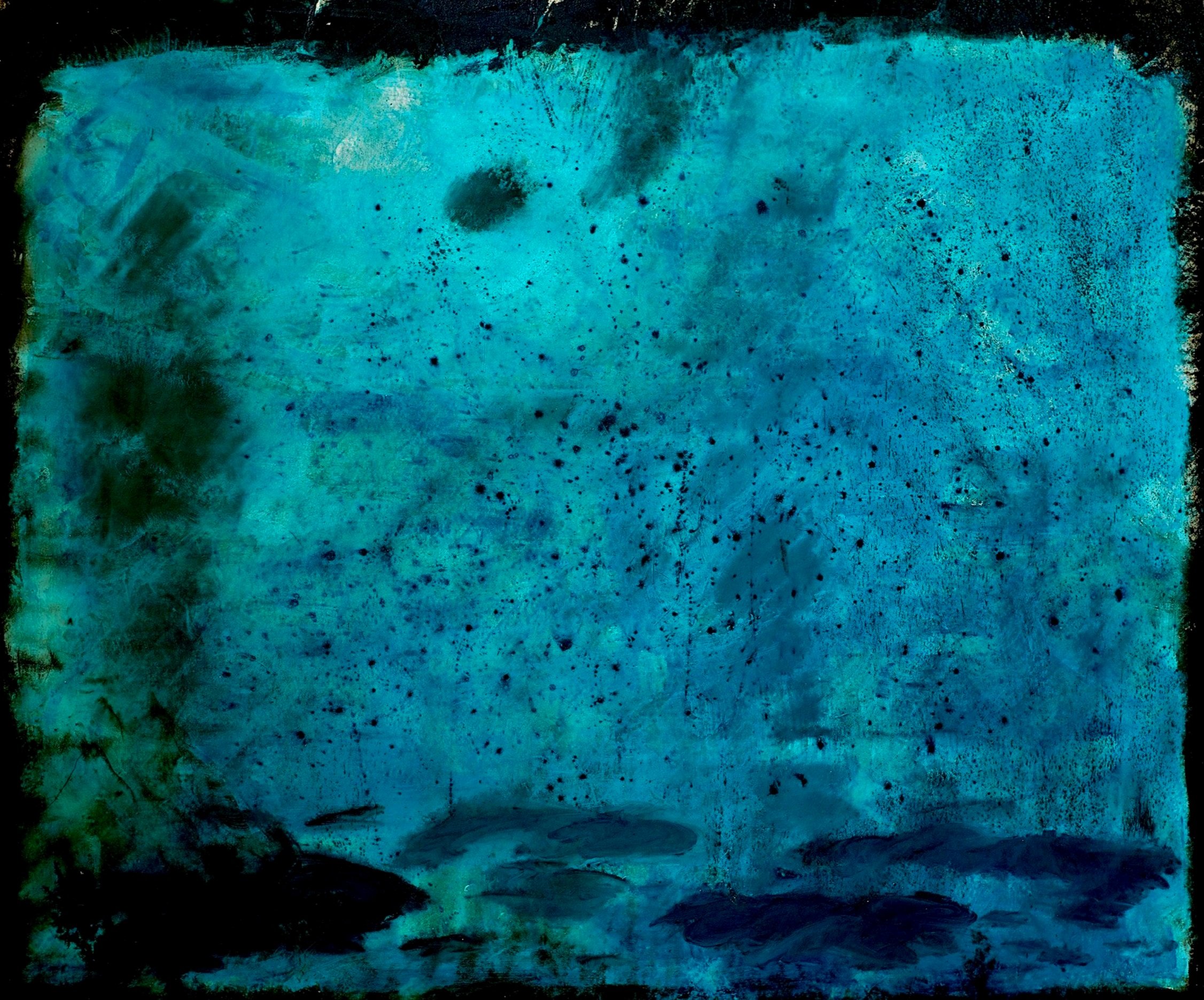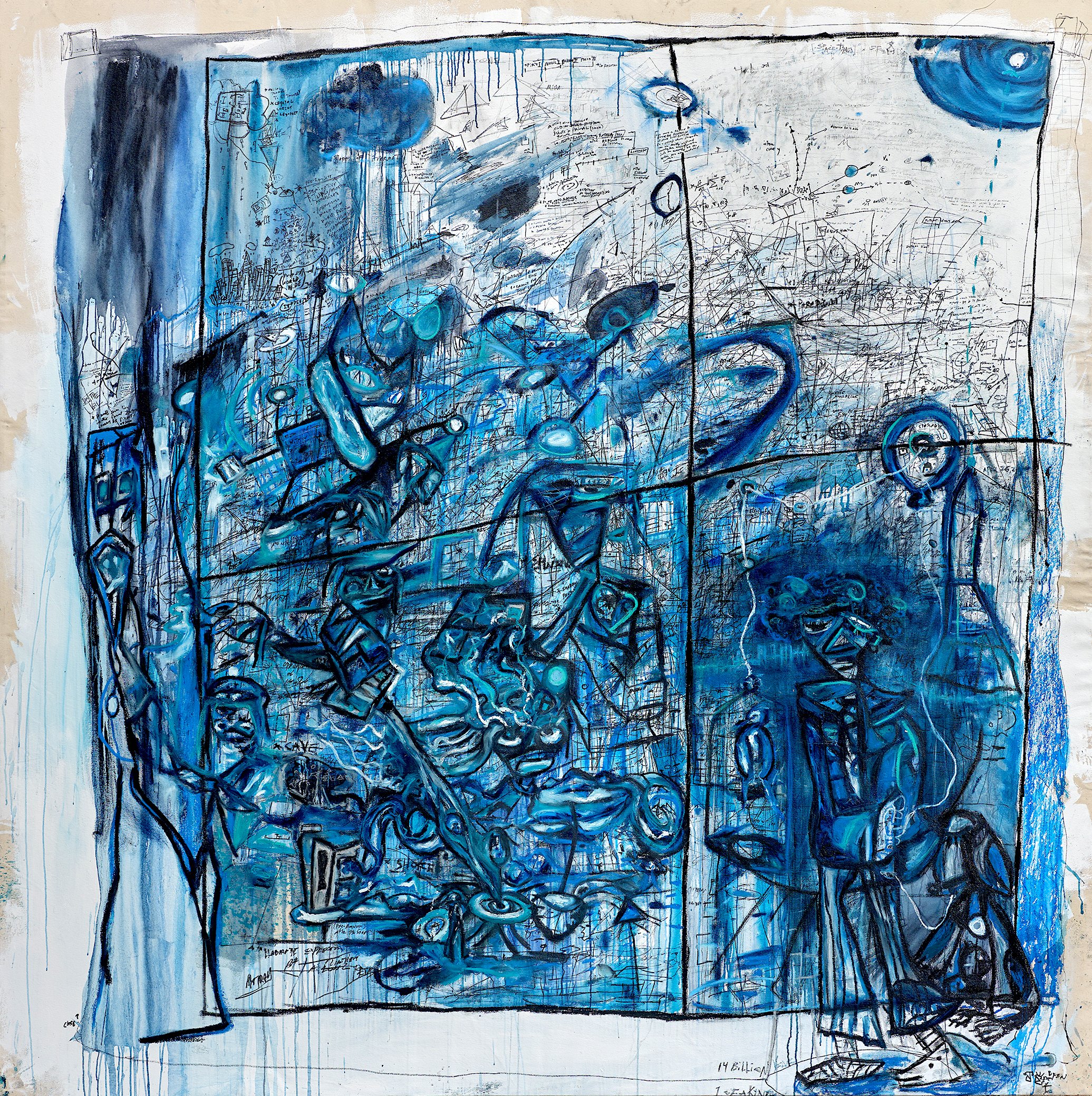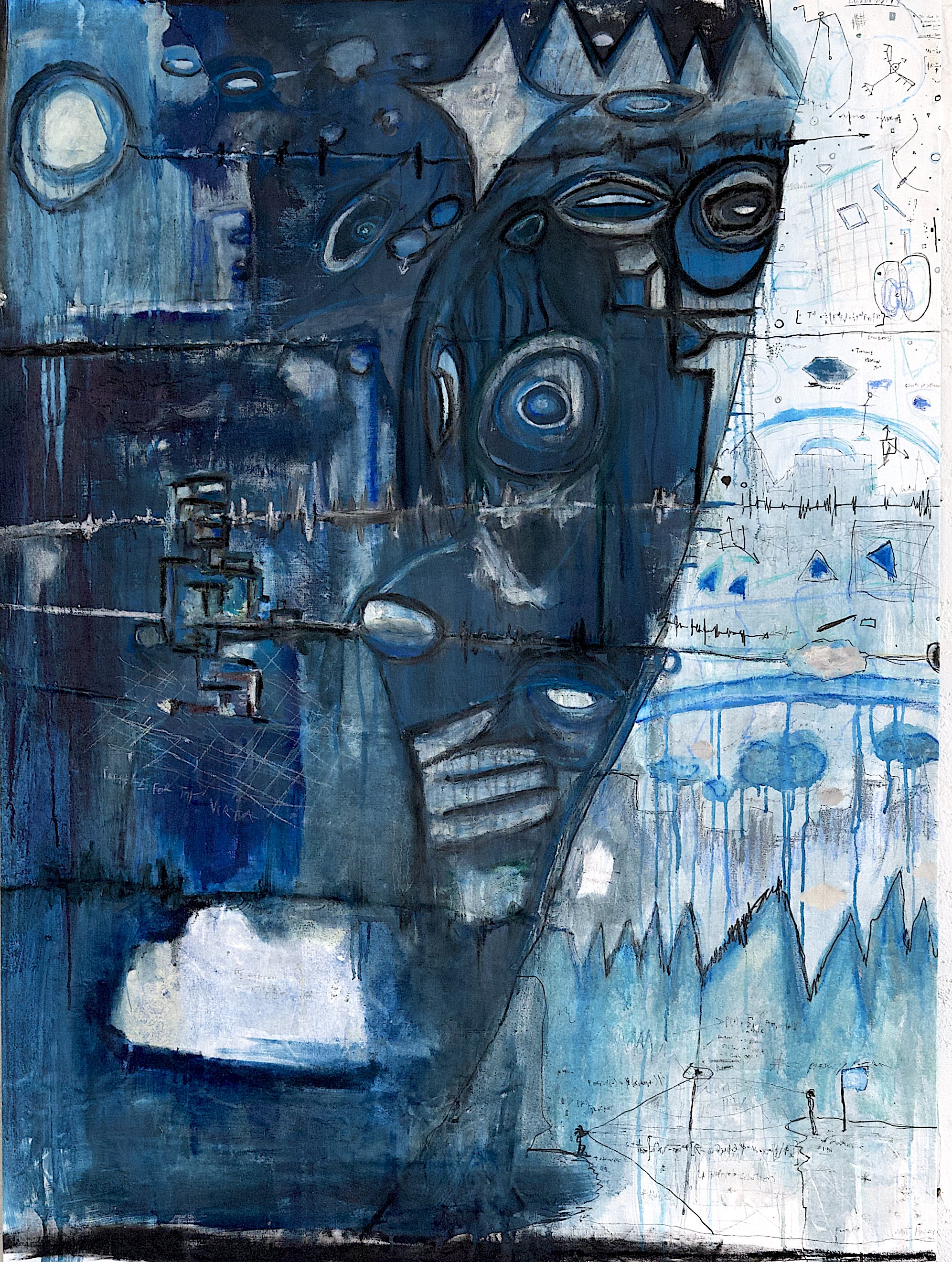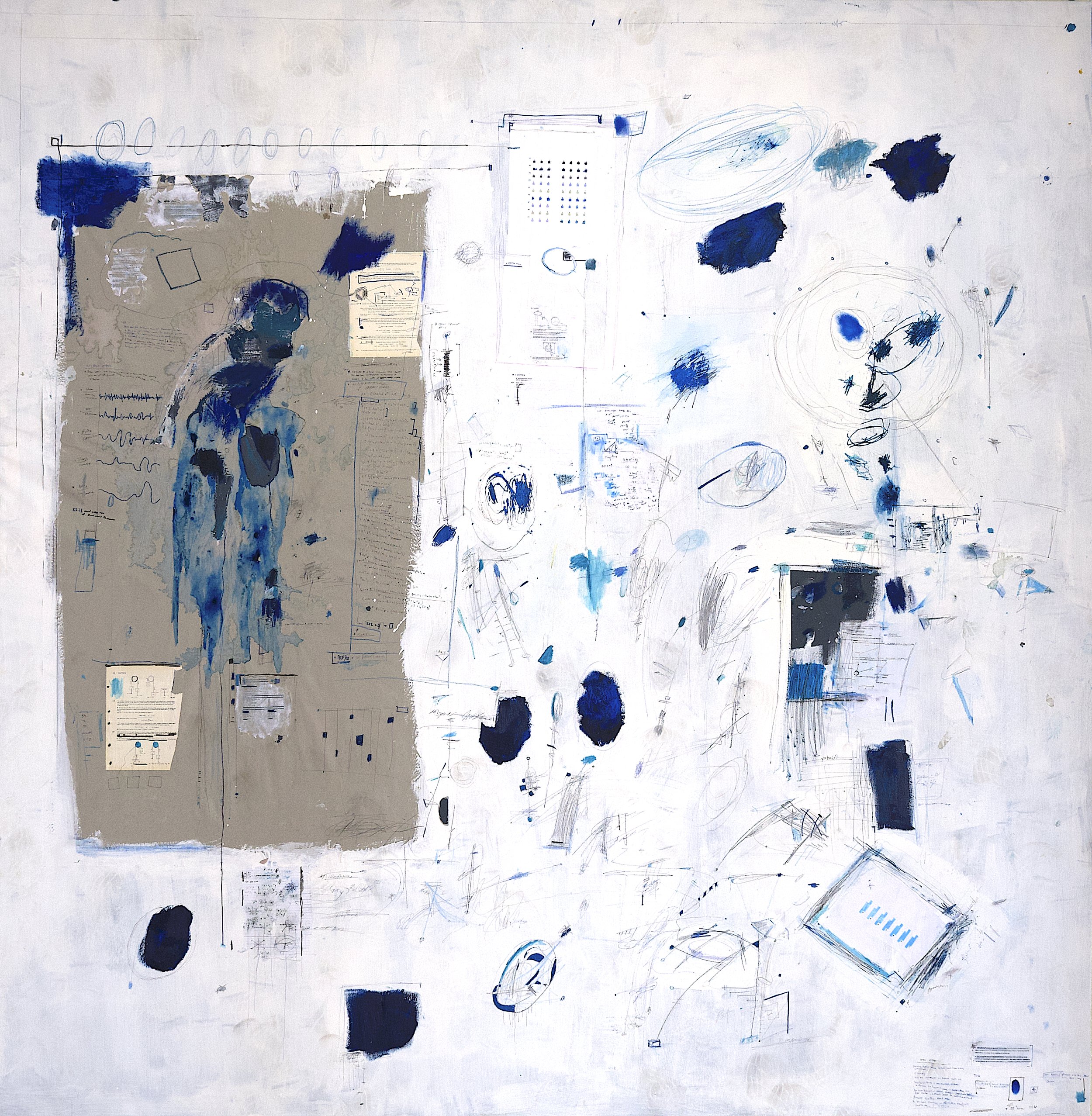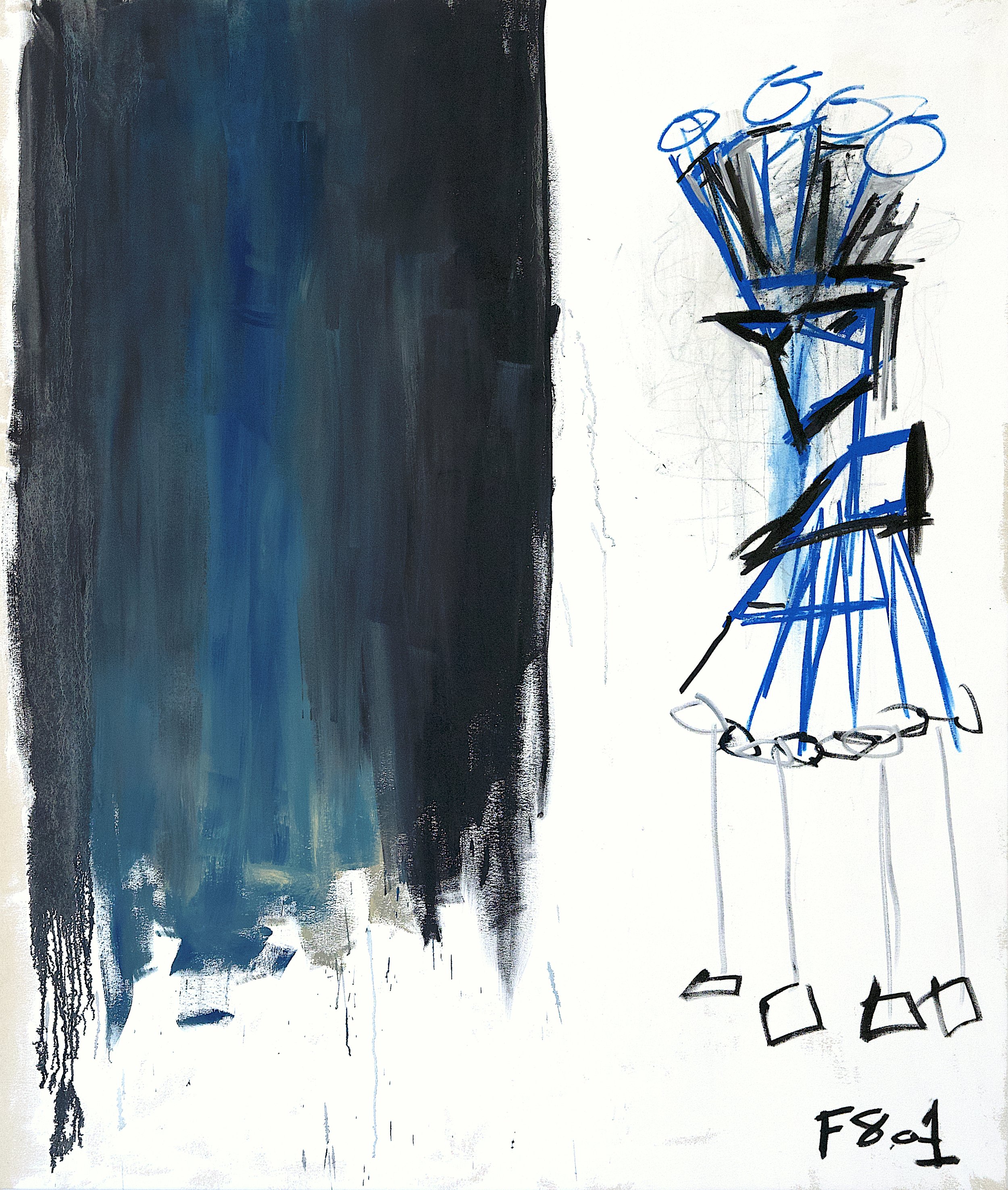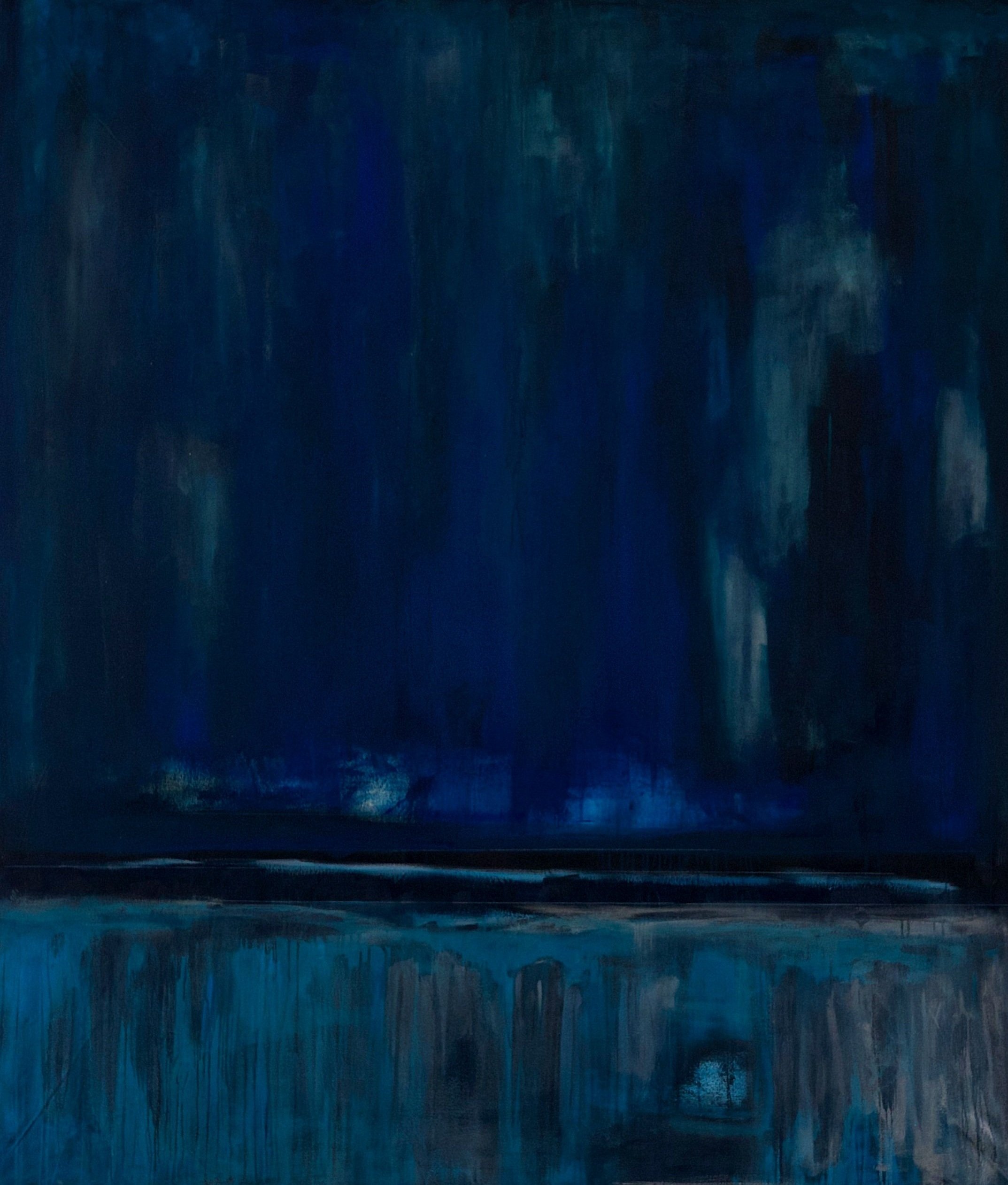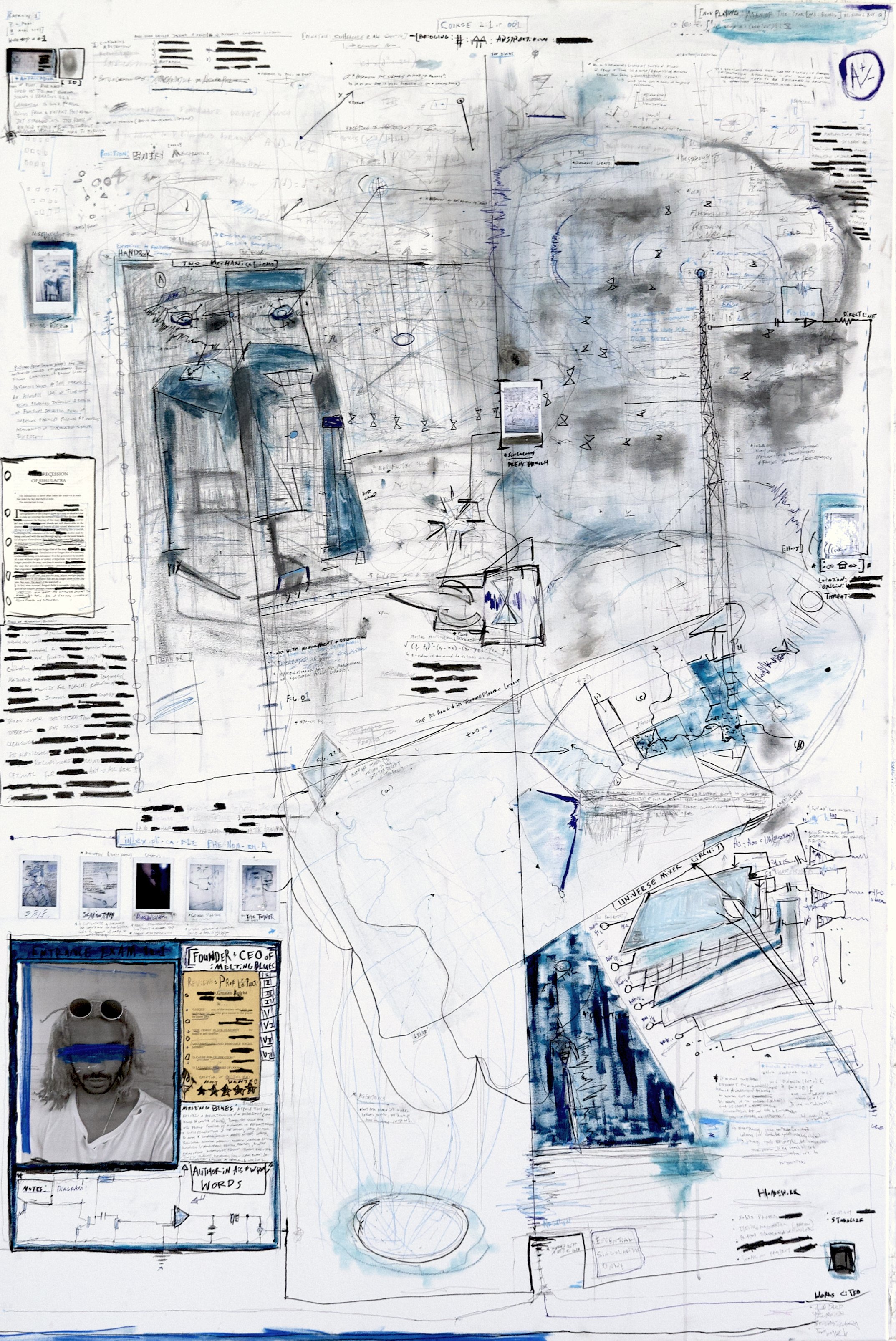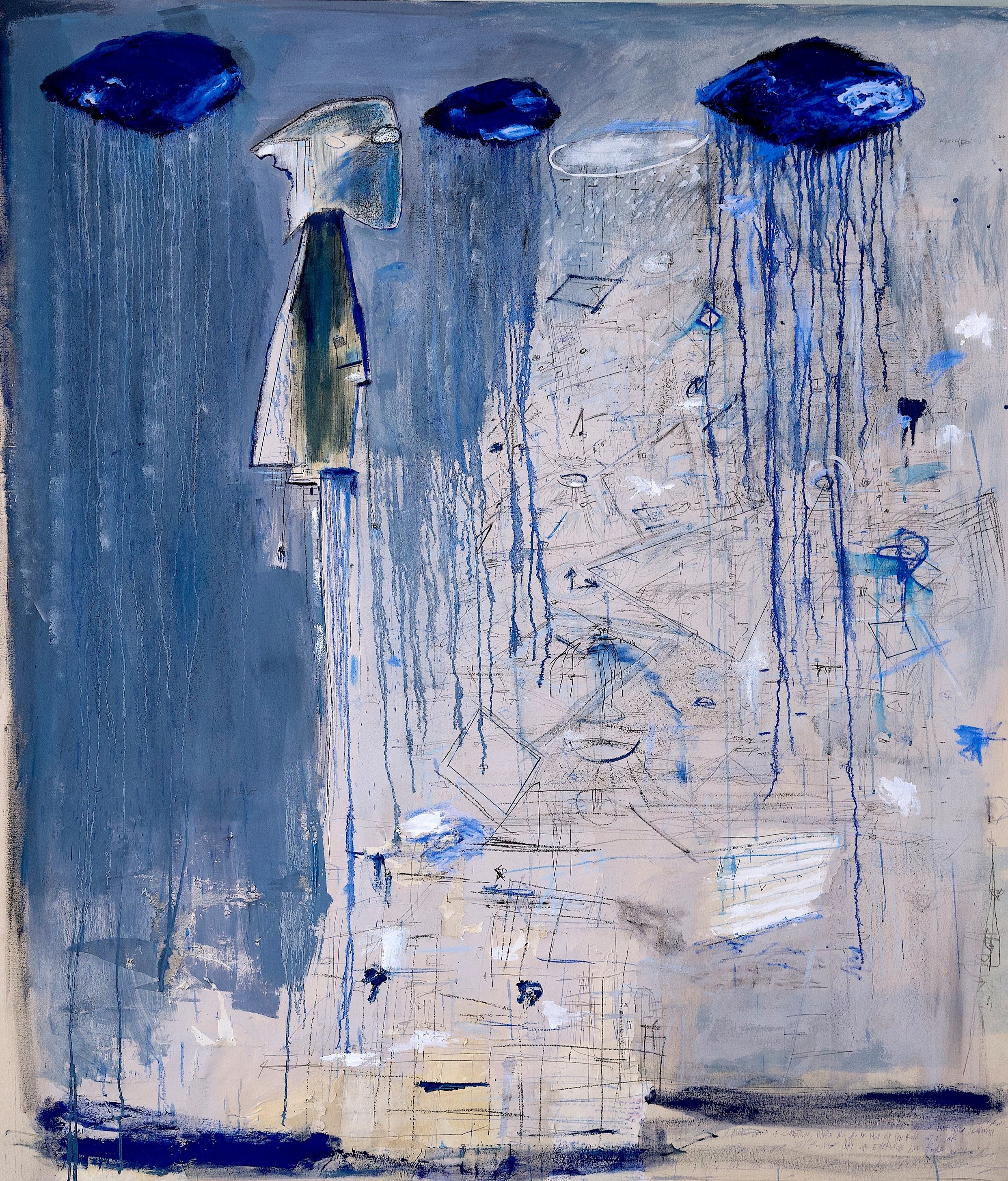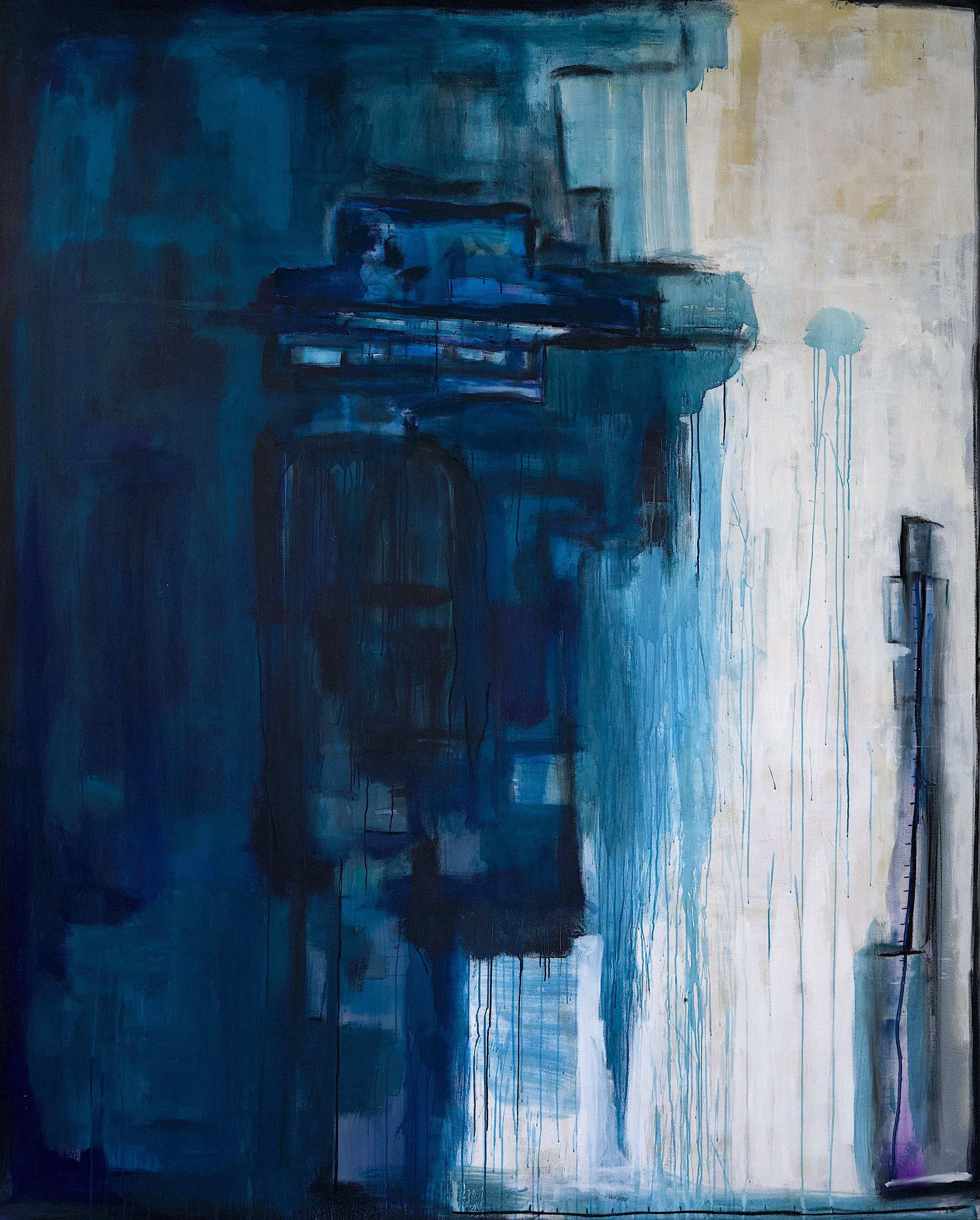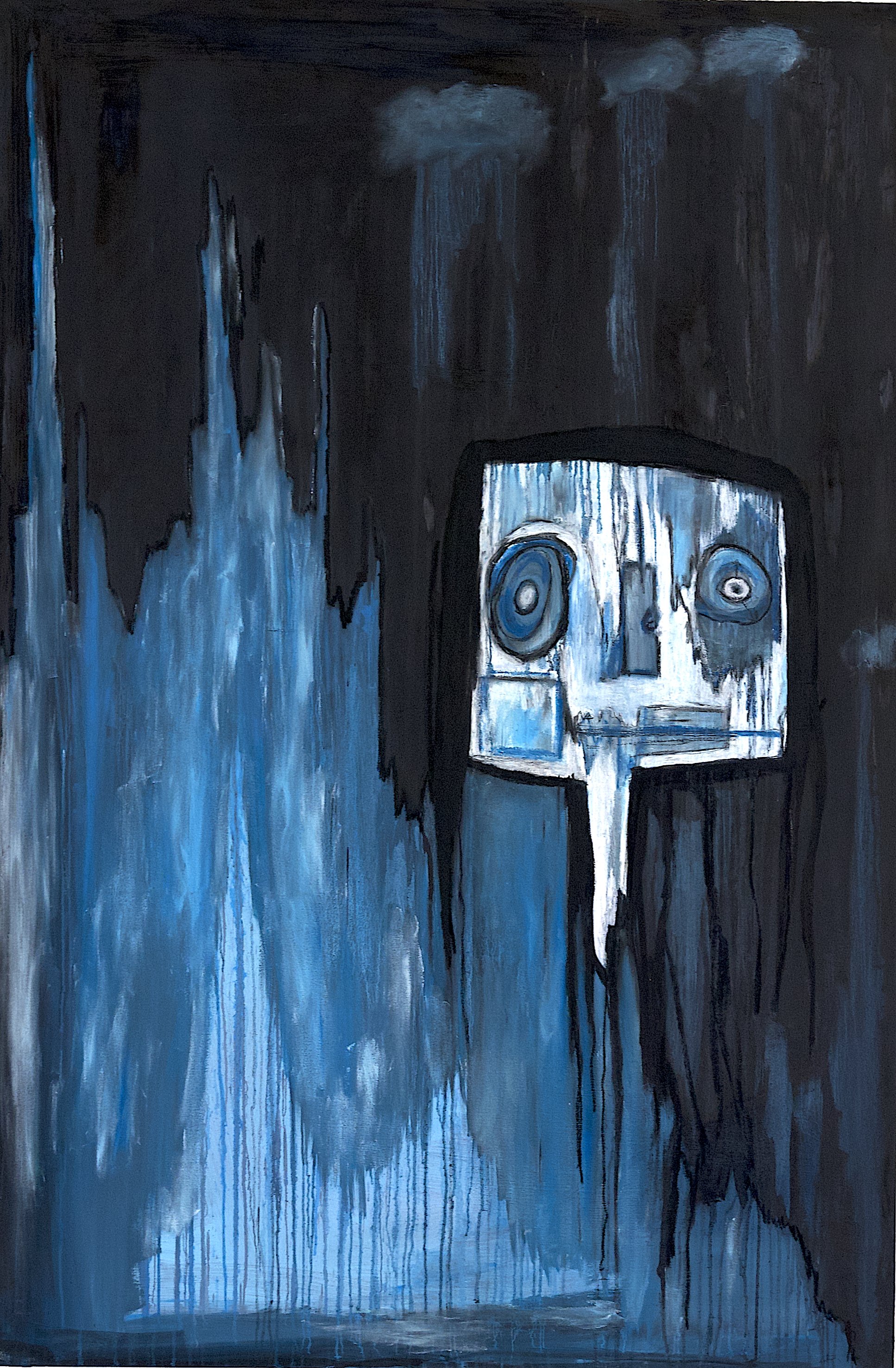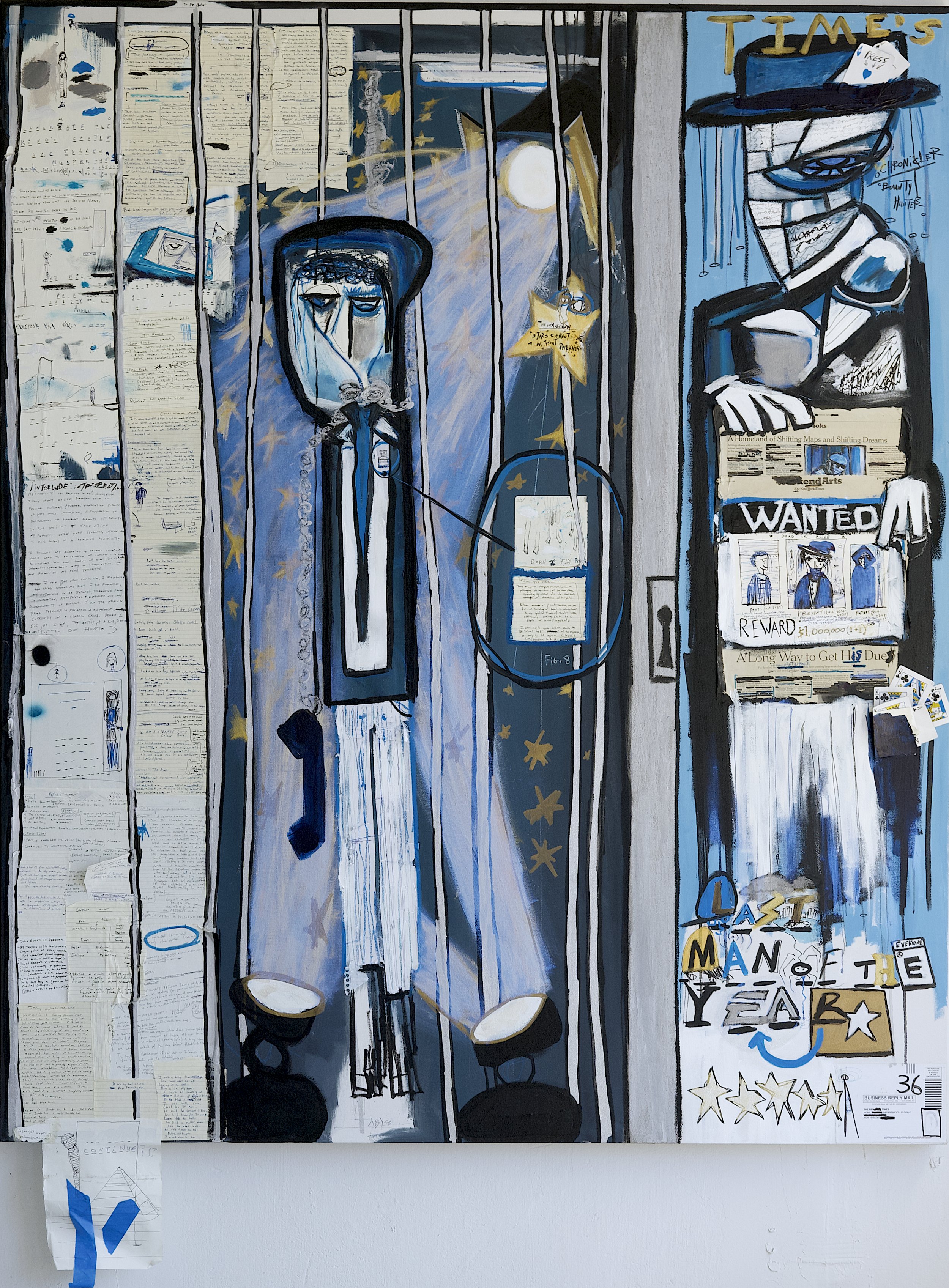The universe is one net. With more holes, the net tightens, and the knit gets more intricate. To know the universe, you have to deal with the strings and the holes. This is the trouble with the universe: the strings imply holes, and the holes imply strings. Form and formlessness wage at war and love. It is a great labor to deal with both strings and holes, oblivion and infinitude at once. Turned inside out and outside in, you labor at the risk of being exploded or collapsed. Jet Le Parti brings us the weave of it all. In no uncertain terms, the artist offers a map: of his thoughts, his learning, of space and time, of mechanisms and magics, of equations and symbols, of science, and of himself.
Today’s works are the ‘Melting Blues.’ Each canvas is filled with vastness and voids, the convergence and collapse of spacetime, and Le Parti’s authenticity amid the profusions of reality. You walk through the three floors of paintings, some of the monumental scale reaching twelve feet, and you are suffused in the artist’s sense of mourning and divinity. The solemnity and ubiquity of the color blue is a visual discipline that balances the artist’s evident sense of excitement, even mania. You imagine him on the floor, on a ladder, and wonder what intensity he must have sustained to create the frenetic expanse now finished before you. In each work, it is as if Le Parti finds a loose thread along the seam of the universe and gives it a tug.
The collection is aptly described by the operative word in its title: “melting” in the progressive tense. The works exist at a precisely chosen melting point as if thawing and releasing ideas previously kept behind ice, like ancient microbes escaping from the heated decay of Arctic glaciers. In Le Parti’s atmosphere, colors, shapes, and universes flow with deep, slow currents and drip into each other. The ‘Melting Blues,’ held at a point just a few degrees above freezing by the force of the painter’s personality, coagulate artworks of the past. You encounter all the Color Field washes, the Twombly scribbles, the Rauschenberg pasting and collaging, the cave drawing figurations, and the de Kooning strokes in a moment of liminal melt.
In ‘Initial Vision,’ it is as if you can see the painting move from gaseous sound to liquid thought to solid vision, the laws of physics temporarily suspended for this particular man. We are only so lucky as to see it in this state of uncertain matter that refuses to stay painted just one way. As in Rothko’s definition of excellent art, the shared elements of uncommonly strong work are all present: death, shape, irony, and depth. But Le Parti is not interested in holding still. If these works are ‘melting’ at some sublime temperature, then they have as much to do with motion as they do with temperature. The paintings vibrate, quiver, and shiver as if they are always just about to break out into the same flurry of motion which must have created them. It is as if each has its own frequency and thus its own kinetics, its own sound, its own aliveness. In their presence, you hold the audience with this aliveness whether you like it or not. It is telling, then, that Le Parti describes himself as a radio tower, the receptor of satellite messages, turning waves into words or images.
“The collection began with a sound,” Le Parti explains. Clear. Precise. Perhaps even piercing, with a kind of violence in its noise.
We mustn’t ask where the sound came from. We can only surmise that Jet Le Parti is its radio tower, receiving some frequency which we might all experience in small vibrations passing through us without ever registering the note. This sound has plucked some chord within Le Parti, a string he is lucky (or unlucky) enough to have in his person. Today, Le Parti brings sound into our world in a collection of graphite, inks, acrylics, collages, oils, and watercolors. To bring the noise into our realm, Le Parti makes new spaces: voids, chasms, crevices, seams of reality. Such spaces were translated into the visual realm by using the sound Le Parti heard pre-fabrication as if he has used echolocation; Le Parti emits his special wavelengths of genius and returns with the echoes bounced off the unseen, quivering matrix of reality. These echoes are enough to reconstruct maps of hidden truths, like sonar on the unlit ocean floor.
You get the sense that Le Parti is working on some divine homework assignment, a problem set straight from the mystic physicist’s classroom. There are no right answers, only a deep sense that the purpose of existence is to appreciate the scale of these mysteries and to venerate those who have found or who may be onto a solution to the riddles troubling Le Parti.
Best of all, Le Parti refuses to obfuscate. His thoughts and process of meaning-making are all present on the canvas. He uses whatever language he can find or needs to share his insights: trigonometry, journal entries, black hole swirls, physics equations, edited pages from Baudrillard, polaroids, and timelines of human history. It is this practice of collection and display that makes the artist quite like a Found Objects artist if the objects here are understood as pieces and bytes of concepts. By any means necessary, Le Parti transmits without a need for cloaking or shyness. His ego is here, and so are his mistakes. His insides and outsides bared for your exploratory surgery of the works. You have to imagine Le Parti had no anesthesia in getting here.
‘Melting Blues’ are what the artist calls “the onset of the relativistic.” It is a special relativity, if you will, however, because these pieces are fearless endeavors. No topic is too mystical or bold, too intellectual or scientific. The terms of what information is too complex or too obscure to be “understood” by the layman are rejected. That quantum physics or philosophy or math or black holes or time are too difficult to be comprehended and that such concerns are best left to the experts is a construction we hide behind and here has been deconstructed. In ‘Introduction of Mechanics’, Le Parti goes through the painstaking mathematical steps of arriving at the proof for our well-accepted fact “a square has 4 sides”. You imagine he brought the canvas to class, taking notes in his chicken scratch right on the linen. Le Parti wants to understand the proof down to the granular mechanisms of trigonometry. Or you imagine him in his studio with a journal recording in humble graphite, a passage read aloud by Deleuze, which plays from a YouTube video. How is this true? Seems a dominant question, both in the ethos of the entire collection and in the small instantiations you find amid the web, examples of a feverish desire to unwind some of the string, to see the very stitches of truth. In this collection, Le Parti refuses to hide behind himself or anyone else. He dares to do the exploration that makes a usual person spooked by failure, an insufficient IQ, or the number of years since they last took a math course. In this sense, you must award him the word “intrepid.” And you must thank him for his impulse to be that radio tower, decoding its signal for anyone to see and asking for nothing but your attention in return.
Exhibition Text Review / Claro C. 2021.
Exhibition:
Jet Le Parti / Melting Blues: Onset of the Relativistic
